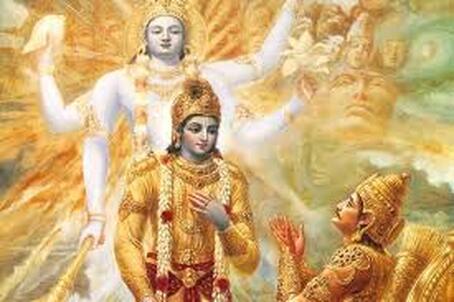May we find refuge in quiet beauty of Nature.
May we find beauty, inspiration and refuge in scripture.
May we find beauty, inspiration and refuge in scripture.
Buddhist and Hindu Scriptures.
This webpage lists the titles of each section of each webpage of my translations of scripture. To access content, go to the menu at page head, click onto the + next to “more”, then click onto the + button next to “scriptures”
Krishna addressing Arjun in the Bhagavad Gita.
The Bhagavad Gita.
G 1. Introduction to the Bhagavad Gita.
G 2. I Offer a New Translation of the Bhagavad Gita.
G 3. Chapters 2, 3 & 4.
G 6. Bhagavād Gita Chap 6 on Meditation.
G 9. Bhagavād Gita Chap 9 on Deity.
G 9. An Offering to Deity.
G 12. Bhagavād Gita Chap 12 on Devotion.
G 11. Equipoise or Samah.
G 11. Shanti = peace.
G 13. Bhagavād Gita Chap 13 on Managing Mind and Body.
G 14. Bhagavād Gita Chap 14 on 3 Guṇa.
G 2. I Offer a New Translation of the Bhagavad Gita.
G 3. Chapters 2, 3 & 4.
G 6. Bhagavād Gita Chap 6 on Meditation.
G 9. Bhagavād Gita Chap 9 on Deity.
G 9. An Offering to Deity.
G 12. Bhagavād Gita Chap 12 on Devotion.
G 11. Equipoise or Samah.
G 11. Shanti = peace.
G 13. Bhagavād Gita Chap 13 on Managing Mind and Body.
G 14. Bhagavād Gita Chap 14 on 3 Guṇa.
The Sage deep in samādhī. Note the composure of the face, and the smile of ānanda.
Mandukya Upanishad.
The Upanishads and samādhi.
māṇḑūkya upaniṣad and prajn͂aḥ = pra-jn͂āna
māṇḑūkya upaniṣad and ॐ aum.
māṇḑūkya upaniṣad text
māṇḑūkya upaniṣad and prajn͂aḥ = pra-jn͂āna
māṇḑūkya upaniṣad and ॐ aum.
māṇḑūkya upaniṣad text
Isha Upanishad
1. īśa upaniṣad translation
2. Mortal and Immortal.
3. om pūrṇam adah pūrṇam idam
4. Acknowledgements.
5. A Clear and Comprehensible Translation of the Upanishads.
2. Mortal and Immortal.
3. om pūrṇam adah pūrṇam idam
4. Acknowledgements.
5. A Clear and Comprehensible Translation of the Upanishads.
The smile of Buddha meditating
The Buddhist Charter of Free Enquiry.
F 1. What Religious Instructions Should We Follow?
F 2. The Kālāma Sutta, AN 3. 65 or 3. 66
Discussion of Kālāmā Sutta.
F 3. The Questionable.
F 2. The Kālāma Sutta, AN 3. 65 or 3. 66
Discussion of Kālāmā Sutta.
F 3. The Questionable.
Selections from The Dhammapada.
The Need for New Translations of Buddhist Scriptures.
The Need for New Translations of Buddhist Scriptures.
I provide new translations, word for word, for several famous Buddhist Suttas or Sutras, which are discourses of Buddha. They are famous, for they explore the deeper Dharma, that helps us move towards spiritual Liberation.
Three Suttas have their own webpages. Others are nested into my treatise on Spiritual Practice thus -
Why new translations?
Buddhism is a monastic religion. These Suttas were traditionally reserved for Buddhist monks, who adhere to monastic rules and detach from worldly pursuits. It’s a very different lifestyle and outlook on life, and uses a different type of language for its studies.
The modern world has its own problems – isolation from Nature and sense of community, lack of jobs and/or job satisfaction, lack of meaningful relationship and real culture, health problems from chemical and irradiating biohazards. Further detachment is likely to aggravate such difficulties, for the real need is to re-establish connection with what we have lost.
Therefore, themes of detachment that are traditionally read into these Buddhist Suttas, might hinder more than help us in these troubled times. New translations using more appropriate language might be more suitable. The new approach also frees up the Source material from traditional politics, that demands they be translated and presented in a certain way.
In addition, all is not well in traditional Buddhism, as practised in Buddhist countries. As a result, traditional translations and interpretation of important Buddhist scripture is not necessarily helpful to daily life, or even relevant. Similar problems might also bedevil Hinduism and traditional translations of the ancient Upanishads. I discuss these problem of Buddhism in my webpage with url -
http://www.mantra-translate.org/broken-buddhism.html
Furthermore, India and Buddhist countries of southern Asia have hot, wet, monsoonal climate, which is quite unsuitable for storing paper, and storing information recorded on paper. Buddhist scriptures are full of repetitions to aid the oral tradition which preserves the scriptures through ritual chanting. These repetitions easily confuse the real import of the Buddha’s teaching, again leading to unhelpful traditional interpretations.
All this calls for some selection and adaption when we (try to) make use of these ancient Buddhist and Hindu scriptures. I select those passages that show promise, and leave the rest on the webpage that I quote from. The adaption need not be major : just add a few missing words, omit unhelpful or unnecessary words, re-arrange word sequence, and adjust noun declension and word translation, and use the dictionary. I discuss noun declension on my webpage entitled “Sanskrit Cases.”
I find that the bulk of the Pali or Sanskrit can still be used, for these promising passages. In addition, the process of adaption enables me to use passages that I would otherwise have to leave unused and unmentioned.
In this process, we begin with a thorough understanding of the dynamics of spiritual practice, and then search scripture for material that might express this understanding. Instead of starting with the traditional wording of scripture, and then allowing that to govern practice. Instead of trying to explain and justify scripture written for a totally different lifestyle. Or trying to explain and justify scriptural interpretations encumbered by strange and obscure religious doctrines.
To achieve this, we need word-for-word translation. I provide this. Then we can pull apart the translation from the religious scholars, and choose other English words that better reflect our experience. Word-for-word translations are transparent, educative, and gives us the original form of the scripture.
This approach also introduces us to the sacred languages of Sanskrit and Pali. (pāỊi is a less melodious accent or dialect of saṃskrt). The sacred language is placed side by side with the worldly language, with diacritics retained to indicate proper pronunciation. In this, the sacred language is supposed to be articulated, to help gain full benefit. We need to get out of this “One Language” of English, and explore others.
May the beauty of sacred language attract us to the beauty of spiritual practice.
Is the Scripture Original?
How does the Pali and Sanskrit of scripture compare with the original words of the (founding) sage of millennia ago? There can be a belief among the devout that the two are the same and not different. But this is only a belief that some people might like to support.
It is better to consider the process of (trying to) preserve ancient religious compositions over the decades, centuries and eventually millennia.
The skill of paper making and printing originated in China almost two millennia ago. It eventually spread north west along the trade routes thru the Gobi desert north of the Himalayas, to the dry regions we call ‘Arab’ countries. This technology did not travel south of the Himalayas into monsoonal south Asia. Paper simply rots there. Thus written records on paper were not available to Hinduism and Buddhism in south Asia. So the scriptures were preserved primarily by the oral tradition. Writings on palm leaves and engravings on stone were secondary and supplementary.
When the Pali Text Society of London began transliterating then translating Buddhist scriptures into English in the 1880’s, the oldest manuscripts they could find were no more than 150 years old. Yet the scriptures were 2500 years old!
We literate Westerners were educated through books and the written word. We find it hard to believe that millions of words of scriptures could be preserved accurately and reliably by oral tradition. Yet when the education was book-free, then people had to remember things by heart, and they took pride in such skill. There were no books to rely on. And individual groups of monks would learn tens of thousands of words of scriptures, because they recited them all very frequently. Different groups would recite different ‘baskets’ = pitaka of scriptural knowledge.
But whether the compositions were preserved by writing or by reciting, the question to ask is this. What was the motivation to preserve the composition? The priestly class were taught to venerate the compositions of these ancient (founding) sages, and their responsibility was to preserve what had been handed down. Indeed, Buddhist monks and Hindu Brahmans have preserved a lot!
Thus the Vedas and Upanishads of Hinduism are classed as śruti = ‘heard.’ Similarly, Buddhist scriptures often begin with evaṁ me suttaṁ = ‘thus I have heard.’ There is no unsubstantiated claim that these scriptures are the exact wording of the ancient (founding) sages.
It is impossible to believe that the historical Buddha actually delivered his talks in the form they have been preserved. The innumerable repetitions are simply too awkward, cumbersome and boring. I have heard over a hundred Dhamma talks from leading Buddhist speakers, and NONE of them were ever delivered in scriptural form. The monks would never have got their jobs in the first place, if they gave talks like that. But the original discourses of the Buddha needed to be put into a form suitable for recitation, so the monks could preserve them.
Of course, there will be phases in history when the scriptures were ‘corrected’ to suit the politics of those times. We should not be naïve about this inevitable process. All institutions have their politics, and the successful operator always gets their politics right.
But when I study the Pali and Sanskrit that has been preserved, I find the material quite promising. For this reason, I provide new translations of old scriptures. I feel called upon to bring their usefulness to light. I feel people need access to this new material. Thus I have become a pioneer in new presentation of the Dharma.
I have been very fortunate that my translations have been available to so very many people. Visitors to mantra-translate now number hundreds every week. I am very grateful that Google gives such high search rankings to my webpages.
Three Suttas have their own webpages. Others are nested into my treatise on Spiritual Practice thus -
- The First Sermon; the Four Noble Truths of Buddhism, that link desire to suffering, dhamma·cakka·pavattana sutta, Samyutta Nikaya 56. 11. In section I 4 of Desire.
- Characteristics of Not Me, Not Mine, anattā lakkhaṅa sutta, Samyutta Nikaya 22. 59. In section D 9 of Self Realisation.
- Discourses on Nibbana = nirvāṇa, Udana 8. 1 – 3. In section D 6 of Self Realisation (a less famous sutta).
Why new translations?
Buddhism is a monastic religion. These Suttas were traditionally reserved for Buddhist monks, who adhere to monastic rules and detach from worldly pursuits. It’s a very different lifestyle and outlook on life, and uses a different type of language for its studies.
The modern world has its own problems – isolation from Nature and sense of community, lack of jobs and/or job satisfaction, lack of meaningful relationship and real culture, health problems from chemical and irradiating biohazards. Further detachment is likely to aggravate such difficulties, for the real need is to re-establish connection with what we have lost.
Therefore, themes of detachment that are traditionally read into these Buddhist Suttas, might hinder more than help us in these troubled times. New translations using more appropriate language might be more suitable. The new approach also frees up the Source material from traditional politics, that demands they be translated and presented in a certain way.
In addition, all is not well in traditional Buddhism, as practised in Buddhist countries. As a result, traditional translations and interpretation of important Buddhist scripture is not necessarily helpful to daily life, or even relevant. Similar problems might also bedevil Hinduism and traditional translations of the ancient Upanishads. I discuss these problem of Buddhism in my webpage with url -
http://www.mantra-translate.org/broken-buddhism.html
Furthermore, India and Buddhist countries of southern Asia have hot, wet, monsoonal climate, which is quite unsuitable for storing paper, and storing information recorded on paper. Buddhist scriptures are full of repetitions to aid the oral tradition which preserves the scriptures through ritual chanting. These repetitions easily confuse the real import of the Buddha’s teaching, again leading to unhelpful traditional interpretations.
All this calls for some selection and adaption when we (try to) make use of these ancient Buddhist and Hindu scriptures. I select those passages that show promise, and leave the rest on the webpage that I quote from. The adaption need not be major : just add a few missing words, omit unhelpful or unnecessary words, re-arrange word sequence, and adjust noun declension and word translation, and use the dictionary. I discuss noun declension on my webpage entitled “Sanskrit Cases.”
I find that the bulk of the Pali or Sanskrit can still be used, for these promising passages. In addition, the process of adaption enables me to use passages that I would otherwise have to leave unused and unmentioned.
In this process, we begin with a thorough understanding of the dynamics of spiritual practice, and then search scripture for material that might express this understanding. Instead of starting with the traditional wording of scripture, and then allowing that to govern practice. Instead of trying to explain and justify scripture written for a totally different lifestyle. Or trying to explain and justify scriptural interpretations encumbered by strange and obscure religious doctrines.
To achieve this, we need word-for-word translation. I provide this. Then we can pull apart the translation from the religious scholars, and choose other English words that better reflect our experience. Word-for-word translations are transparent, educative, and gives us the original form of the scripture.
This approach also introduces us to the sacred languages of Sanskrit and Pali. (pāỊi is a less melodious accent or dialect of saṃskrt). The sacred language is placed side by side with the worldly language, with diacritics retained to indicate proper pronunciation. In this, the sacred language is supposed to be articulated, to help gain full benefit. We need to get out of this “One Language” of English, and explore others.
May the beauty of sacred language attract us to the beauty of spiritual practice.
Is the Scripture Original?
How does the Pali and Sanskrit of scripture compare with the original words of the (founding) sage of millennia ago? There can be a belief among the devout that the two are the same and not different. But this is only a belief that some people might like to support.
It is better to consider the process of (trying to) preserve ancient religious compositions over the decades, centuries and eventually millennia.
The skill of paper making and printing originated in China almost two millennia ago. It eventually spread north west along the trade routes thru the Gobi desert north of the Himalayas, to the dry regions we call ‘Arab’ countries. This technology did not travel south of the Himalayas into monsoonal south Asia. Paper simply rots there. Thus written records on paper were not available to Hinduism and Buddhism in south Asia. So the scriptures were preserved primarily by the oral tradition. Writings on palm leaves and engravings on stone were secondary and supplementary.
When the Pali Text Society of London began transliterating then translating Buddhist scriptures into English in the 1880’s, the oldest manuscripts they could find were no more than 150 years old. Yet the scriptures were 2500 years old!
We literate Westerners were educated through books and the written word. We find it hard to believe that millions of words of scriptures could be preserved accurately and reliably by oral tradition. Yet when the education was book-free, then people had to remember things by heart, and they took pride in such skill. There were no books to rely on. And individual groups of monks would learn tens of thousands of words of scriptures, because they recited them all very frequently. Different groups would recite different ‘baskets’ = pitaka of scriptural knowledge.
But whether the compositions were preserved by writing or by reciting, the question to ask is this. What was the motivation to preserve the composition? The priestly class were taught to venerate the compositions of these ancient (founding) sages, and their responsibility was to preserve what had been handed down. Indeed, Buddhist monks and Hindu Brahmans have preserved a lot!
Thus the Vedas and Upanishads of Hinduism are classed as śruti = ‘heard.’ Similarly, Buddhist scriptures often begin with evaṁ me suttaṁ = ‘thus I have heard.’ There is no unsubstantiated claim that these scriptures are the exact wording of the ancient (founding) sages.
It is impossible to believe that the historical Buddha actually delivered his talks in the form they have been preserved. The innumerable repetitions are simply too awkward, cumbersome and boring. I have heard over a hundred Dhamma talks from leading Buddhist speakers, and NONE of them were ever delivered in scriptural form. The monks would never have got their jobs in the first place, if they gave talks like that. But the original discourses of the Buddha needed to be put into a form suitable for recitation, so the monks could preserve them.
Of course, there will be phases in history when the scriptures were ‘corrected’ to suit the politics of those times. We should not be naïve about this inevitable process. All institutions have their politics, and the successful operator always gets their politics right.
But when I study the Pali and Sanskrit that has been preserved, I find the material quite promising. For this reason, I provide new translations of old scriptures. I feel called upon to bring their usefulness to light. I feel people need access to this new material. Thus I have become a pioneer in new presentation of the Dharma.
I have been very fortunate that my translations have been available to so very many people. Visitors to mantra-translate now number hundreds every week. I am very grateful that Google gives such high search rankings to my webpages.
May the light of Dharma illumine our Path in life.
The Satipatthana Sutta.
M 1. Introduction.
M 2. Four Foci for Attentiveness.
Mindfulness of the Body = kāy-ānupassanā
M 3. Preliminaries Needed for Meditation.
M 4. Meditation on the Breath = Ānāpāna.
M 5. Meditation Throughout the Day.
M 5. Inhabiting the Body (kāye).
Mindfulness of Feelings = vedan-ānupassanā
Mindfulness of Thoughts (and State of Mind) = chitt-ānupassanā
M 6. Noting and Naming Thoughts.
Mindfulness of the Dharma or Spiritual Qualities
= dhamm-ānupassanā.
M 2. Four Foci for Attentiveness.
Mindfulness of the Body = kāy-ānupassanā
M 3. Preliminaries Needed for Meditation.
M 4. Meditation on the Breath = Ānāpāna.
M 5. Meditation Throughout the Day.
M 5. Inhabiting the Body (kāye).
Mindfulness of Feelings = vedan-ānupassanā
Mindfulness of Thoughts (and State of Mind) = chitt-ānupassanā
M 6. Noting and Naming Thoughts.
Mindfulness of the Dharma or Spiritual Qualities
= dhamm-ānupassanā.
The Heart Sutra.
H. Introducing śūnyatā
H 1. Pronunciation Guide.
H 2. The Five skandhā or Categories.
H 3. The Formula Clarified.
H 4. The Body is śūnyatā or Empty.
H 5. Mind is śūnyatā.
H 6. All Dharma is Śūnyatā .
H 7. In śūnyatā there is no Doctrine.
H 8. Beyond skandhas, Beyond the Sense Doors.
H 9. śūnyatā can mean “The Way to Liberation”
H 10. Beyond the Body.
H 11. Beyond the Mind.
H 12. Beyond the Sense Doors.
H 13. Conclusion : gate gate paragate.
H 14. Reference : Edward Conze.
H 1. Pronunciation Guide.
H 2. The Five skandhā or Categories.
H 3. The Formula Clarified.
H 4. The Body is śūnyatā or Empty.
H 5. Mind is śūnyatā.
H 6. All Dharma is Śūnyatā .
H 7. In śūnyatā there is no Doctrine.
H 8. Beyond skandhas, Beyond the Sense Doors.
H 9. śūnyatā can mean “The Way to Liberation”
H 10. Beyond the Body.
H 11. Beyond the Mind.
H 12. Beyond the Sense Doors.
H 13. Conclusion : gate gate paragate.
H 14. Reference : Edward Conze.
Traditional Buddhism – Success or Failure?
1. The Original Practises of the Buddha.
2. Vinaya or monks' rules summarised.
3. Corruption and Decadence in the Religion.
4. The Origins of Vinaya.
5. Information Sources.
2. Vinaya or monks' rules summarised.
3. Corruption and Decadence in the Religion.
4. The Origins of Vinaya.
5. Information Sources.
May the Light of scripture convey us across the ocean,
and lift us to the open sky.
and lift us to the open sky.
Good and Evil.
S 2. Precepts in Yoga, Christianity and Buddhism.
S 3. The Three Gunas.
S 3. The Defilements and the Spiritual Qualities.
S 4. Good and Evil in Storey Telling.
S 4. Good and Evil in Spiritual Practice and Healing.




